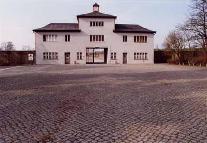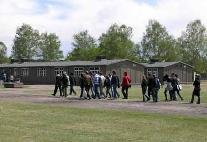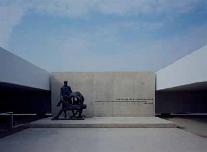EUROPE
Sachsenhausen Memorial and Museum (Germany)
(Oct. 1, 2008)
by Horst Seferens, Press and Public Relations
The Sachsenhausen Concentration Camp was built in the summer of 1936 by concentration camp prisoners. The design of the grounds was conceived by the SS architects as the ideal concentration camp setting, giving architectural expression to the SS worldview, and symbolically subjugating the prisoners to the absolute power of the SS. As a model for other camps, and in view of its location just outside the Reich capital, Sachsenhausen acquired a special role in the National Socialist concentration camp system. This was reinforced in 1938 when the Concentration Camp Inspection Office, the administrative headquarters for all concentration camps within the German sphere of influence, was transferred from Berlin to Oranienburg.
More than 200,000 people were imprisoned in Sachsenhausen between 1936 and 1945. At first the prisoners were mostly political opponents of the Nazi regime. However, increasing numbers of members of groups defined by the National Socialists as racially or biologically inferior were later included. By 1939 large numbers of citizens from the occupied European states arrived. Tens of thousands of people died of starvation, disease, forced labor and mistreatment, or were victims of the systematic extermination operations of the SS. Thousands of other prisoners died during the death marches following the evacuation of the camp at the end of April 1945. Approximately 3,000 sick prisoners, along with the doctors and nurses who had stayed behind in the camp, were liberated by the Russian and Polish troops of the Red Army.
In August 1945 the Soviet secret service, the NKVD, moved Special Camp No. 7 into the core area of the former concentration camp at Sachsenhausen. The camp mostly held minor Nazi functionaries, but also people who were politically undesirable, had been arbitrarily arrested, or been sentenced by Soviet military tribunals. There were men and women, young and old, those with a Nazi past and those with none. After 1948 Sachsenhausen, now Special Camp No. 1, was the largest of three special camps in the Soviet zone of occupation. By the time the camp was closed in March 1950, around 60,000 people had been imprisoned there, of whom at least 12,000 died of malnutrition and disease.
In 1956, after the grounds and barracks had been used for military purposes, plans were prepared for the establishment of the Sachsenhausen National Memorial under East Germany’s administration. The memorial was inaugurated on April 22, 1961. Instead of preserving the remaining original structures, the planners chose to create a memorial site that would symbolize the “victory of anti-fascism over fascism.” Only a few original buildings and reconstructions were incorporated into it.
As a result of the fall of the Berlin Wall and the reunification of Germany, Sachsenhausen Memorial and Museum has, since January 1993, been part of the Brandenburg Memorials Foundation. This is a public trust, funded equally by the Federal Republic of Germany and the state of Brandenburg. As soon as the Foundation had been established, extensive rehabilitation and remodelling work began. The inherited state of the memorial is characterised by the thorough transformation of its historical topography into the memorial complex installed in the time of the GDR. The shift of emphasis towards the camp relics from the Nazi period brings with it a re-evaluation of the various historical layers. The implementation of key rehabilitation projects is funded by a federal government special investment program.
Today, 11 modern museums and exhibitions give information about the different layers of Sachsenhausen’s history to visitors from around the world. One of the museums presents relevant material and portrays the biographies of ex-prisoners. On display are photos, films, objects, drawings, and documents, from the personal collections of ex-prisoners and visitors can listen to prisoners describing their lives on numerous recordings. We also exhibit the site of the gallows, the execution grounds, and the kitchens of prisoners.
After completion of the remodelling work, Sachsenhausen Memorial and Museum remains a place of mourning and remembrance in a European context, while facing up to the tasks of a modern museum of history.
Address: StraBe der Nationen, 16515 Oranienburg, Germany
Tel: +49-(0)3301-200200
Homepage: http://www.stiftung-bg.de
Days closed: Every Monday, December 24 and 31
Admission: Free
(Originally published on September 22, 2008)
 Peace Museums of EUROPE
Peace Museums of EUROPE


